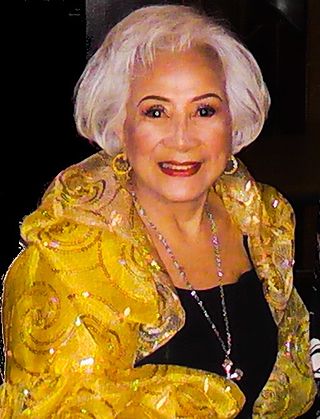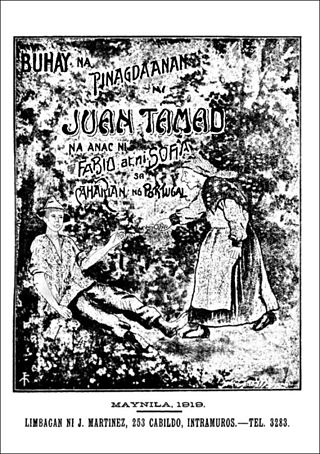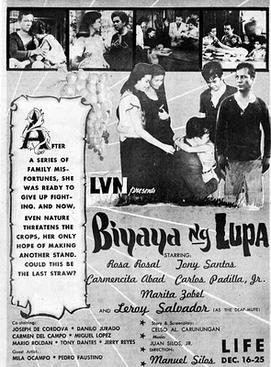Related Research Articles

Manuel Luis Quezon y Molina, also known by his initials MLQ, was a Filipino lawyer, statesman, soldier, and politician who served as president of the Commonwealth of the Philippines from 1935 until his death in 1944. He was the first Filipino to head a government of the entire Philippines, and is considered to have been the second president of the Philippines, after Emilio Aguinaldo (1899–1901), whom Quezon defeated in the 1935 presidential election.

Ronald Allan Kelley Poe, known professionally as Fernando Poe Jr., and often referred to by his initials FPJ, was a Filipino actor, film director, producer, screenwriter, and politician. His long and successful career as an action star earned him the nickname "Da King". He also wrote, directed, and produced several of the films he starred in—under the pseudonyms Ronwaldo Reyes and D'Lanor.
Augusto Valdes Pangan, Sr., professionally known as Chiquito, was a Filipino actor and comedian.

The Cinema of the Philippines began with the introduction of the first moving pictures to the country on August 31, 1897, at the Salón de Pertierra in Manila. The following year, local scenes were shot on film for the first time by a Spaniard, Antonio Ramos, using the Lumiere Cinematograph. While most early filmmakers and producers in the country were mostly wealthy enterprising foreigners and expatriates, on September 12, 1919, Dalagang Bukid , a movie based on a popular musical play, was the first movie made and shown by Filipino filmmaker José Nepomuceno. Dubbed as the "Father of Philippine Cinema," his work marked the start of cinema as an art form in the Philippines.
Lauro Delgado was a Filipino actor, born as Loreto Porciuncula in Bocaue, Bulacan. He was discovered by the director Gerardo de Leon.
Bayani Casimiro Sr. was a Filipino dancer who was among the leading stars of bodabil (vaudeville) in the 1930s and 1940s. He also appeared in musical films and later in life, in comedic roles. A tap dancer, he was frequently dubbed as the "Fred Astaire of the Philippines".
Manuel Barbeyto was a Filipino actor of early 1920s before the war struck in the City of Manila. Barbeyto made his first appearance in the silent movie Mary, I Love You in 1921. He is known to play villanous roles.

Manuel Conde was a Filipino actor, director and producer. As an actor, he also used the screen name Juan Urbano during the 1930s aside from his more popular screen name.

Clarita Villarba Rivera, better known by her screen name Mila del Sol, was a Filipina actress, entrepreneur and philanthropist. Born in Tondo, Manila, she gained fame in her very first lead role in the 1939 film Giliw Ko. She was discovered by LVN Pictures President Doña Sisang de Leon, who insisted in casting her over the objections of the film's director, who felt she was too young for the part. It was the film's director, Carlos Vander Tolosa, who gave her the screen name Mila del Sol for "causing the sun (sol) to appear as if by miracle (milagro) over his otherwise overcast set whenever she was called in to do her scenes."
Giliw Ko is a 1939 Filipino musical romance film. The first production of LVN Pictures, it established the production company's tradition of musical extravaganzas. Directed and written by Carlos Vander Tolosa, it stars Ely Ramos, Fernando Poe, Ely Ramos, Mila del Sol, and Fleur de Lis.
Nemesio E. Caravana was a Filipino film director and actor.
Blue Moon is a 2006 Philippine romantic drama film. Directed by Joel Lamangan, it stars Eddie Garcia, Boots Anson-Roa, Mark Herras, Dennis Trillo, and Jennylyn Mercado. It was released by Regal Films.

Marcelo de Azcárraga Ugarte y Palmero-Versosa de Lizárraga was a Spanish soldier-politician and thirteenth Prime Minister of Spain following the restoration of the Spanish monarchy. He served as Prime Minister in 1897, 1900–1901, and 1904–1905. Azcárraga was the only Spanish Prime Minister of part Insulares, specifically Spanish Filipino, descent.

Juan Tamad is a character in Philippine folklore noteworthy for extreme laziness. He is usually portrayed as a child, although in some interpretations, he is said to be a young man.

Narcisa Buencamino-De León was a Filipino film producer and businesswoman.
Mario Montenegro was a Filipino film actor best known for his heroic leading roles.

Blessings of the Land is a 1959 Filipino drama film directed by Manuel Silos. It was entered into the 10th Berlin International Film Festival. The film won Best Picture and Best Story from the Filipino Academy of Movie Arts and Sciences. In 1960, it was shown at the Asian Film Festival held in Tokyo. The story was written by Celso Al. Carunungan, while the screenplay was written by Carunungan together with Pablo Naval. The movie was produced by LVN Pictures.

Child of Sorrow is a 1956 Philippine crime drama-tragedy film written by Rolf Bayer and directed by Lamberto V. Avellana. Set in the slums of Manila, recovering from the aftermath of the Second World War, the story follows Cita, a prostitute with good intentions and Vic, a war hero who served in the Korean War under PEFTOK, living together in the ravaged capital but when they were involved with Cardo's nasty plans, they, along with Father Fidel, join forces to stop him to succeed.

The Benavides Monument is a memorial in the University of Santo Tomas in Manila, Philippines built to commemorate the founder of the University of Santo Tomas, Miguel de Benavides, O.P. Located in front of the UST Main Building, the monument consists of a bronze statue of Benavides rising on top of a granite pedestal. The present monument was unveiled in 1946.
Iginuhit ng Tadhana , also known as Man of Destiny, is a 1965 Filipino biographical film about then-Senate President Ferdinand Marcos. Directed by Mar S. Torres, Jose de Villa and Conrado Conde, the film stars Luis Gonzales as Marcos, Rosa Mia as Marcos' mother Josefa, and Gloria Romero as Marcos' wife Imelda. The film was produced by 777 Film Productions and was first released by Sampaguita Pictures in the Philippine provinces on August 24, 1965, during Marcos' campaign for president in the 1965 presidential election.
References
- ↑ Tiongson, Nicanor G. (2008). The Cinema of Manuel Conde. University of Santo Tomas Publishing House. p. 62. ISBN 978-971-506-468-2.
- ↑ ""Amazona" opens today at Center". The Manila Times . The Manila Times Publishing Company, Inc. November 11, 1959. p. 5-B.